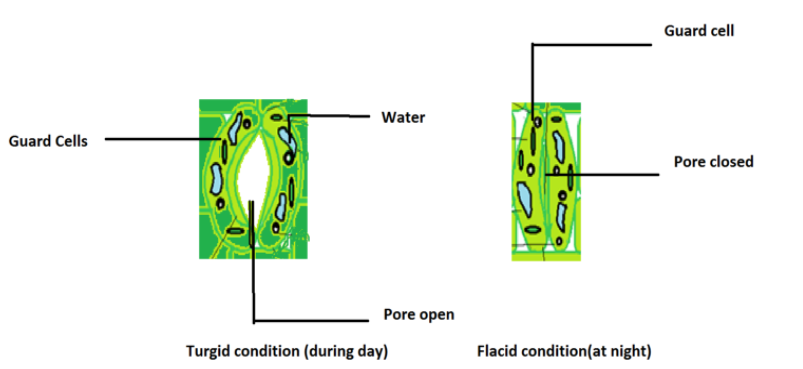
Explain the mechanism of opening and closing of stomata.
Answer
576.9k+ views
Hint: Guard cells regulate the opening and closing of stomata. Sunlight is the main agent to induce the opening and closing of stomata.
Complete answer:
Stomata are the pores present in abundance at the lower epidermis of the leaf. They are also present in the stem. The gaseous exchange and transpiration occur through stomata. The stomata are surrounded by two guard cells which regulate its opening and closing. Stomata open during the day time for gaseous exchange and also release water vapour through transpiration. The opening and closing of stomata is due to the change in turgor pressure of the guard cell.
During the day the roots absorb water due to greater transpiration pull and it is transported to different parts of the plant through xylem. The guard cell on receiving this water swells and becomes turgid. As a result of which the stomatal pore is open.
At night, the roots absorb less water, thus the guard cell becomes flaccid and shrinks. As a result of which stomatal pores closes.

Additional information During the day time plant takes carbon dioxide from the atmosphere for photosynthesis and releases oxygen which we breathe. This gaseous exchange occurs through stomatal pore. At night photosynthesis doesn’t take place. Plants take in oxygen for respiration and release carbon dioxide.
Note: The rate of transpiration is regulated by the guard cells. When the guard cells are turgid, stomata open and when it is flaccid, the stomata closes.
Complete answer:
Stomata are the pores present in abundance at the lower epidermis of the leaf. They are also present in the stem. The gaseous exchange and transpiration occur through stomata. The stomata are surrounded by two guard cells which regulate its opening and closing. Stomata open during the day time for gaseous exchange and also release water vapour through transpiration. The opening and closing of stomata is due to the change in turgor pressure of the guard cell.
During the day the roots absorb water due to greater transpiration pull and it is transported to different parts of the plant through xylem. The guard cell on receiving this water swells and becomes turgid. As a result of which the stomatal pore is open.
At night, the roots absorb less water, thus the guard cell becomes flaccid and shrinks. As a result of which stomatal pores closes.

Additional information During the day time plant takes carbon dioxide from the atmosphere for photosynthesis and releases oxygen which we breathe. This gaseous exchange occurs through stomatal pore. At night photosynthesis doesn’t take place. Plants take in oxygen for respiration and release carbon dioxide.
Note: The rate of transpiration is regulated by the guard cells. When the guard cells are turgid, stomata open and when it is flaccid, the stomata closes.
Recently Updated Pages
Why are manures considered better than fertilizers class 11 biology CBSE

Find the coordinates of the midpoint of the line segment class 11 maths CBSE

Distinguish between static friction limiting friction class 11 physics CBSE

The Chairman of the constituent Assembly was A Jawaharlal class 11 social science CBSE

The first National Commission on Labour NCL submitted class 11 social science CBSE

Number of all subshell of n + l 7 is A 4 B 5 C 6 D class 11 chemistry CBSE

Trending doubts
Differentiate between an exothermic and an endothermic class 11 chemistry CBSE

10 examples of friction in our daily life

One Metric ton is equal to kg A 10000 B 1000 C 100 class 11 physics CBSE

Difference Between Prokaryotic Cells and Eukaryotic Cells

1 Quintal is equal to a 110 kg b 10 kg c 100kg d 1000 class 11 physics CBSE

State the laws of reflection of light




